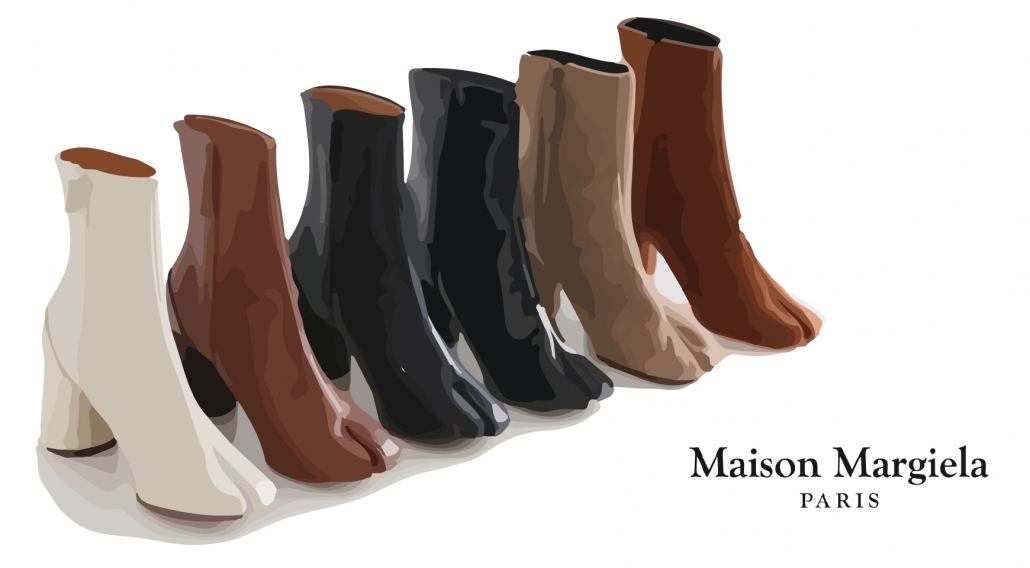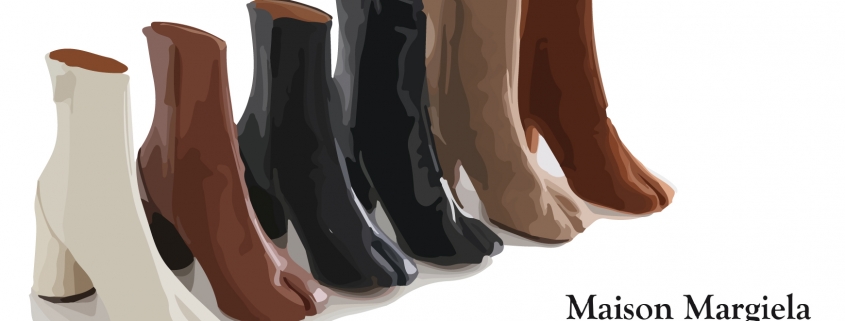Tongue in Chic: I succumbed to the cult of the Margiela Tabi boot

They came from Canada, inside a big cardboard box sporting a lime green Priority Mail Express sticker. The whole thing was mummified with layers of clear packing tape. I had kept a vigilant eye on the tracking number for days, my anxiety multiplying with every delay as the package was held up in customs. It was not until the box was safely inside my apartment, with me hovering over it with a pocket knife, that I finally allowed the tension to leave my body.
Inside the package was a pair of Tabi shoes. If you’re into fashion, you’ll immediately go “Ahhh,” as the above paragraph now makes total sense to you. If you’re not into fashion, you’re probably going “Uh … what?” Allow me to introduce you to one of the most iconic — and controversial — shoes in fashion history.
Martin Margiela, who co-founded the luxury fashion house Maison Margiela, introduced Tabi shoes at his debut show in 1989. They were not an original idea — split-toe shoes, known as jika-tabi, had been worn by Japanese workers as far back as the 15th century. But these Tabi shoes weren’t the flip-flop-esque thonged sandals that the Japanese favored; these were white high-heeled boots with a prominent cleft in the middle. Additionally, Margiela swathed the runway in white fabric and coated the bottoms of the Tabi shoes in red paint, so that as the models walked, they left a trail of distinctive goat-like hoofprints.
The demand for the boots was swift and instantaneous, and never died down. Since the first iteration, Margiela has released Tabi shoes in every design and color you could possibly imagine. There are Tabi boots in metallic pink and sequined silver. There are Tabi ballet flats and Tabi sneakers. In 2019, to celebrate its 30th anniversary, Margiela came out with special edition Tabi keychains, T-shirts and purses. Tabi shoes are to Margiela the way Birkins are to Hermès or red-bottoms are to Louboutin.
Tabi shoes aren’t as polarizing as cilantro, but they come pretty close. It’s impossible to feel ambivalent about them: You either love them or you hate them, and you know which camp you’re in the moment you lay eyes on them. Those who love them wax poetic about its versatility, originality and eroticism (something about that split). They’re a fixture on the feet of first-year Parsons School of Design and Fashion Institute of Technology students. Those who hate them report feeling repulsed and nauseated by the design and can’t possibly fathom why anyone would want to make their feet look like a satyr’s.
As for myself, I’m (obviously) Team Tabi. I see clothes and things I want every day, but nothing inhabited my desires quite like Tabi shoes. I haunted luxury e-commerce sites like SSENSE and Totokaelo, checking nearly every day for price drops and inventory count. But I couldn’t bring myself to take the plunge. Why? Because they’re just under $1,000.
I realize that my writing about buying Tabi shoes may be viewed as an obvious flex. After all, the ability to drop that much money on a single pair of boots necessitates an enormous amount of privilege. I’m very fortunate in that my parents pay my tuition and rent, thus freeing up the money I make myself to be solely discretionary.
For two years, I coveted these shoes. Every month, I’d set aside a portion of my paycheck, in the hopes of one day securing a pair of the OG white boots.
On Black Friday, SSENSE held a blowout sale that knocked a few hundred dollars off the price. Short of buying them secondhand, which I’d scrounged to no avail, this was the cheapest these boots would ever get. I bought them. They arrived in early December, and the moment I sliced through the tape, unfurled the tissue paper and slipped them on my feet was a high I hadn’t experienced and will never again experience.
I have never worn them outside.
It’s not that the boots aren’t everything I’d dreamt of — they are. I think that’s the problem. The leather is smooth and supple, the stitching delicate yet sturdy, the craftsmanship exquisite. It’s just … the thought of such perfection being marred by the dirt and grime of L.A.’s streets — it breaks my heart.
Here’s the thing. White shoes are either for the deeply diligent, who are assiduous enough to coat them in protectant and scour away stains, or the incredibly laid-back, who don’t give a shit if their shoes look like they’ve been through hell. Sadly, I am caught in the middle — too lazy to do the work necessary to keep them pristine but still irrationally upset when a scuff mark appears. I just know that an errant smudge is inevitable, and I also know that in such an event my nervous collapse is also inevitable. Do I really want to inflict that emotional turmoil on myself?
After two straight years of ardent longing, I guess it should come as no surprise that I’m too precious about my Tabi shoes to ever subject them to their intended purpose. So for now, I keep them painstakingly wrapped up in their original shoebox, high up on a shelf in my closet.
Maybe one day I’ll muster up the courage to wear them. Maybe.
Kitty Guo is a senior writing about fashion. Her column “Tongue in Chic” runs every other Monday.

